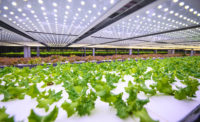Seed to Landfill: Food and Environmental Safety Are Inseparable
Recall the old and pragmatic concept practiced on farms and ranches for centuries: conservation. Even though we are not talking about the buzzwords of sustainability or climate change, food safety cannot be separated from environmental safety; they are the same for all practical purposes.
Both the world and food industry are changing, and along with it, social responsibility from a sustainability view point. Environmental factors are becoming more and more integrated in the food industry. Food is big business; for example, IBM and British Petroleum are now contributing to research initiatives in food production.
In the era of biomass waste turned into energy and bioengineered seeds planted for food, there is much information to absorb about our food and its landscape. Seed handed to farmers yields agricultural products that are carried to grocery stores, cooked on our stoves, served on our plates, and the waste from this process ends up in landfills or, if done correctly, is used to create energy. It is important to note that waste decomposing in landfills generates methane; it doesn’t matter that you were mindful and grew your food organically. If carbon dioxide is considered harmful, methane can be considered as having a bigger impact on the environment unless it is captured, stored and used as natural gas energy. Note that 40 percent of waste in landfills is from construction, not food.
At what point does the safety of your food start and what really is food safety? Why is this important? Today’s biosensors have the specificity, sensitivity and selectivity of detecting pathogens down to one molecule. If these expensive instruments were in common use, we’d probably have no issues with the safety of our food, but the challenge is that the scope and definition of food safety is changing, because it is effecting the triple bottom line of people, planet and profit.
Could just a change of habit in what we take in eventually change what ends up in the landfills and result in better byproducts to be used as biomass for energy production?
Change the Ratio; Your Food Quotient
According to the American Journal of Nutrition, there is evidence that the macronutrient composition of the diet and the maintenance of energy balance are related. Intervention studies show that subjects lose weight on low-fat diets and gain weight on high-fat diets. Descriptive studies show that overweight subjects eat relatively more fat but have the same total energy intake as non-overweight subjects. The body has a limited ability to oxidize fat compared with its ability to oxidize carbohydrate and protein. The conclusion is that becoming overweight can be prevented by reducing the fat content of the diet. However, the type of fat matters, as olive oil, for example, can contribute to higher metabolism and lowering of weight; cultures that consume olive oil have a smaller rate of breast cancer. Even bacteria in our gut can change their DNA based on foods we consume.
According to Scientific American, there is an association between the presence of supermarkets and lower obesity rates. Convenience stores, on the other hand, were associated with higher rates. It must be determined whether the food itself and/or the containers that hold the food contribute to the seed-to-landfill (StL) problem.
There is little data on food waste, but according to scientists at the University of Arizona, food thrown away by supermarkets, both in developing and developed nations, are worth a staggering $30 billion dollars per year. The buyer’s demand is the price that is paid to have cosmetically organized and decorated food in our grocery stores. This is because about 30 percent of fruits and vegetables in North America are tossed out before they even hit the supermarket, according to the Toronto Food Policy Council. Unwanted household food adds up to about 25 percent of landfills. A good question is, how much of that food can be recovered for composting or for biomass programs to create energy?
Today, we use genetically modified seeds that prevent crop failure and starvation because they do well under stressful conditions (severe weather, salinity, disease, pests, etc.) in areas most prone to disasters and crop failure. Could genetic engineering have a solution for the environmental effects of food production? It is important to state that organically grown food is a method of growing food whether the seed is genetically modified or not. In other words, you can grow genetically modified organic vegetables and fruits.
To achieve a solution for “wicked problems,” interdisciplinary collaboration is required by scientists in genetic engineering, environmental engineering, molecular biology, food safety, petroleum and energy scientists, biomedical engineers and social psychologists. Such teams can offer revolutionary and evolutionary methods to potentially transform our society. What technology do we need to solve the StL problem? Could it be as simple as rethinking our ways and consider the Japanese model where technology, business and government work together for the betterment of a nation? This puts competition aside temporarily until things are sorted out for the greater good, which itself is a subject of debate.
How can we contribute to the development of a solution and resist certain practices while coming up with innovations? The upcoming challenge in food and environmental safety may be dealing with the byproducts of nanotechnology and their uses while we use these innovative technologies to address our greatest challenges.
Sal Rastegar is an energy consultant at www.MakeGreenCount.com.
Looking for a reprint of this article?
From high-res PDFs to custom plaques, order your copy today!








